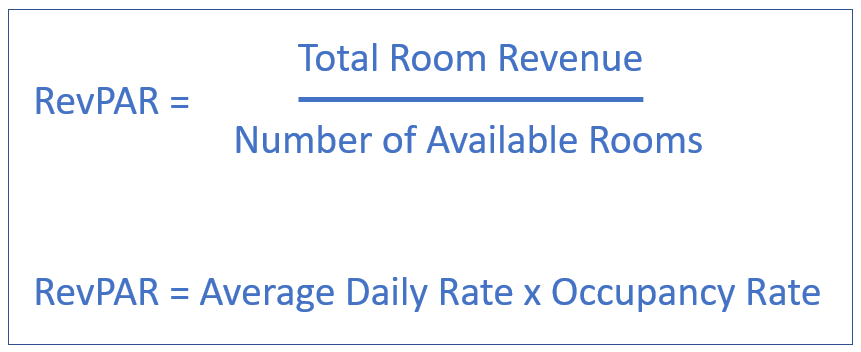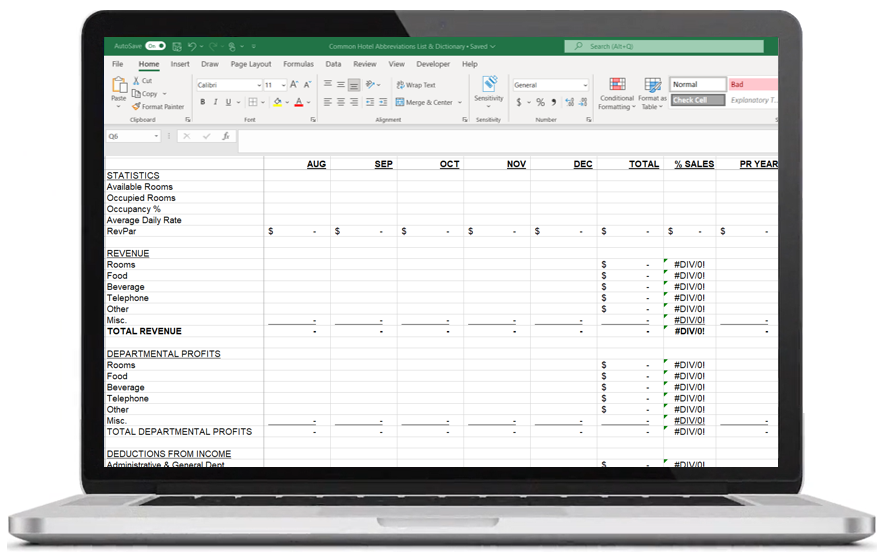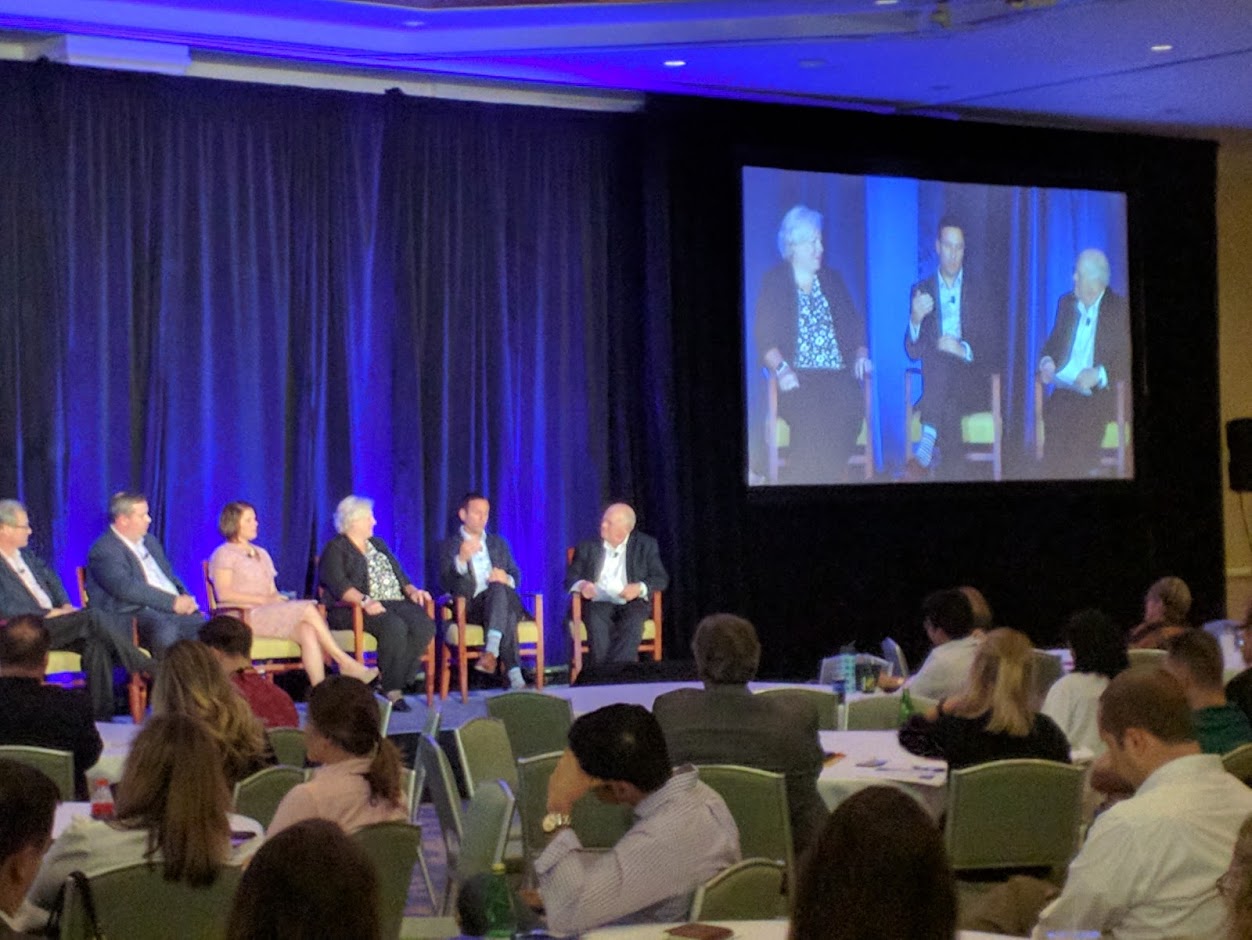
RevPAR is a key performance indicator (KPI) that many hoteliers consider the most important of all is RevPAR (Revenue Per Available Room). This page provides a full rundown of RevPAR from its meaning and formula to tips on how to improve it.
What is RevPAR?
RevPAR represents the revenue generated per available room, whether or not they are occupied. RevPAR helps hotels measure their revenue generating performance to accurately price rooms. Since it’s such a widely used metric, RevPAR can help hotels measure themselves against other properties or brands.
RevPAR is used to assess a hotel’s ability to fill its available rooms at an average rate. If a property’s RevPAR increases, that means the average room rate or occupancy rate is increasing.
How to Calculate RevPAR? (RevPAR formula)
There are two formulas you can use to calculate RevPAR:
- Rooms Revenue ÷ Rooms Available
- Average Daily Rate x Occupancy Rate

Free RevPAR Calculator [Excel]
We know organizing data and calculating formulas is the last thing anyone wants to do, which is why we’ve created a free worksheet to streamline the process. This worksheet also includes calculations for ADR, ARR, and Occupancy Rate!
Download your RevPAR worksheetto determine your:
|
Why is RevPAR important?
RevPAR is important because it helps hoteliers measure the overall success of their hotel. But as useful as it is to illustrate growth, RevPAR doesn’t account for profit — and while growth and profit sometimes go hand in hand, this is not always the case.
However, there are alternatives to RevPAR that can help hoteliers better measure both profitability and growth by taking into account several other factors — namely costs and occupancy rates.
Still, no matter which metric is used, the goal stays the same: To increase revenue and profits. In this post, we will discuss the formulas you can use to calculate RevPAR, the alternative KPIs, and offer strategies for increasing RevPAR — or GoPAR or ARPAR or whichever metric you prefer.
The Problem with RevPAR
As helpful as RevPAR can be in calculating revenue, there are several pitfalls to this key metric.
For one, RevPAR doesn’t take into account CPOR (costs per occupied room). Because of this, it can’t be used as a key metric in measuring profitability — arguably the number one goal of most hotels.
RevPAR also doesn’t account for any additional income the hotel generates from other departments such as catering, parking, or the spa.
RevPAR Alternatives
While RevPAR’s industry popularity makes it easy to compare revenue figures across properties and brands, RevPAR misses the mark for hoteliers looking at profit, not just revenue. As a result, alternative metrics have emerged to help hotels measure performance in terms of growth, profits, and revenue.
TrevPAR
TrevPAR Calculation: Total Revenue / Total Number of Rooms
TrevPAR stands for the total revenue per available room. TrevPAR takes into account total revenue of the property across all outlets, like the spa, the pool, and restaurants. But, like RevPAR, TrevPAR fails to account for cost factors and occupancy rate.
While TrevPAR is a great measurement for accountants, hotel owners, and general managers seeking a high-level view of profitability, it’s less beneficial for revenue managers because it doesn’t enable them to isolate revenue streams.
ARPAR
Calculation: (ADR – variable costs per occupied room + additional revenue per occupied room) x Occupancy
ARPAR is adjusted revenue per available room. It’s a great metric to measure the performance of revenue management and the overall effectiveness of a hotel’s pricing policy.
ARPAR is similar to RevPAR, except that ARPAR takes into account revenue and costs per occupied room. Costs per occupied room that greatly influence ARPAR and hence profitability include cleaning, energy usage, water usage, internet and TV, supplies such as toiletries, etc. There are several costs that can be subtracted from the revenue generated by each occupied room, as reflected in the ARPAR formula.
GOPPAR
Calculation: Gross operating profit / (per) available room
GOPPAR is gross operating profit per available room. This is a helpful measurement for hotel owners looking for a general picture of their property’s performance, as it looks at all rooms regardless of if they are occupied or not. While GOPPAR is a strong indicator of performance across all revenue streams, it includes room variables like internet bills and hotel furniture costs that hotel managers have little control over.
How to improve RevPAR?
Goals and job role will help hotels determine which metric (or combination of metrics) makes sense for them. Whatever the case, the goal remains the same: increase revenue and profits while decreasing costs.
Here are 7 ways to improve RevPAR:
1. Understand demand patterns. Since hotel demand is essentially inelastic, it’s important for hoteliers to thoroughly understand customer consumption patterns.
By understanding demand patterns, hotels can implement strategic pricing policies that allow them to charge more than their competitors and still fill rooms. Understanding demand also means that hoteliers don’t have to aggressively discount rooms during slow demand months — potentially eating into profits if costs outweigh revenue — since they will be covered by revenue brought in during peak season. A great place to start to get fresh insights on occupational trends in your location is by accessing our Hospitality Market Insights Hub.
2. Deliver an exceptional customer experience. Charging more than the competitor might sound obvious, but the reality of it is something more elusive.
Today, everything comes down to the customer experience. In a highly competitive market, customers expect a lot — so hotels that want to charge a premium must be skilled at service delivery. This means they must be able to offer a better hotel experience consistently and sustainably. Otherwise, the only other option is to build a better product, which means fancier spas, nicer furnishings, etc. — physical attributes that are static once implemented.
To increase the average daily rate, hotels need to deliver consistent service across every outlet of the property. Demand, after all, drives ADR. That demand is generated though consistently meeting guest expectations which triggers word-of-mouth referrals, repeat visits, and hopefully loyal customers.
3. Implement a length of stay requirement. For hotels that can implement one effectively, length of stay requirements can be such a successful tactic that entire revenue management strategies are created around it.
There are several ways by which a hotelier can choose to implement a length of stay requirement. For example, a hotel may implement this requirement for any rooms sold through a certain channel like Expedia. Or, a hotel may choose to implement a length of stay requirement for certain promotional packages it’s marketing or during a certain week when they know there is a large event in town. The applications are numerous, but the point is the same: Hoteliers can help control costs by limiting guest turnover, hence helping drive profit.
4. Consider predictive intelligence. An emerging trend in the hotel industry is the ability to leverage predictive intelligence technology to better understand guest behavior. Predictive intelligence gathers guest data — including behavior and activity — then creates aggregate models that help hoteliers deliver better, more personalized customer service.
5. Implement a chat-enabled web collaboration tool. Guests today don’t like to pick up the phone, which poses a problem for hotels looking to deliver an exceptional guest experience. With a chat-enabled web app, hoteliers can engage with guests digitally and in real time. It’s a win for the consumer and for the hotelier, who is able to provide an instant answer or complete a booking online and without having to pick up the phone.
6. Be proactive, not reactive. It all goes back to the customer experience. Most hotels are reactive, which doesn’t help them create that “magic moment” when a customer is so delighted with the level of service they’ve received, that they go and tell all of their friends — and then come back time and time again.
For instance, if it’s raining and a hotel staff member notices a guest headed to the door without an umbrella, the staff member may offer an umbrella to the unprepared guest. However, this is only possible if the hotel is prepared and proactive about anticipating guests’ needs.
7. Utilize automation software. Automation software such as property management systems, sales and catering software, customer relationship management, and central reservation systems can help hotels significantly improve efficiencies and deliver a better, more personalized experience.
Competition today is fierce and consumer demands can be hard to keep up with. With hotel automation software, properties of every size and budget can improve RevPAR, ARPAR, or whichever metric they choose to measure their success.
Similarly, automation software and the strategies discussed in this post can help increase gross operating profits and gross revenues, two important KPIs for measuring a management company’s success.
While delivering the level of service offered by the luxury hotels of the world may seem impossible, technology is the ultimate equalizer; offering even the smallest, most budget-conscious hotels the ability to deliver a level of customer service once only afforded by luxury budgets.
Hoteliers looking for ways to improve customer service and profits should consider the benefits of today’s cloud-based technology, most of which is able to integrate with other key hotel operating systems and provide a holistic property view.
We hope this article about RevPAR meaning and formula was useful for you and don’t hesitate to contact us so we can learn about your goals and offer solutions to help you grow.
Looking for more resources to help you excel in revenue management? Check out our Hospitality market trends & reports hub for fresh, comprehensive hospitality market data to help inform your business and pricing strategy.




![[Webinar Recording] Hospitality Crisis Management (Latin America)](/wp-content/uploads/2020/04/Webinar-Recording-Hospitality-Crisis-Management-Latin-America.webp)

